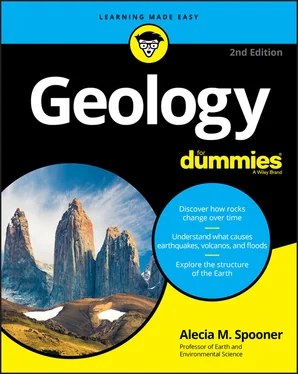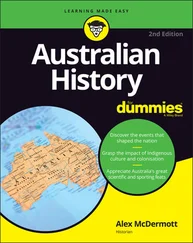In publishing his book, Lyell spread Hutton’s ideas and popularized them. The concept that “the present is the key to the past” was groundbreaking at the time and inspired scientific thought in fields outside of geology, such as Darwin’s ideas about evolution.
 The basic principle that Hutton proposed, called uniformitarianism, is still the foundation of geologic science. Simply put, it states that past geologic phenomena can be explained by drawing on observable processes occurring today.
The basic principle that Hutton proposed, called uniformitarianism, is still the foundation of geologic science. Simply put, it states that past geologic phenomena can be explained by drawing on observable processes occurring today.
Uniformi-what? Understanding the Earth through Uniformitarianism
The idea that geologic processes we observe today have always been occurring and can be used to explain the features of the earth has stood the test of time. In fact, now more than ever, geologists recognize that the physical, chemical, and biological processes that occur today must have occurred in the past as well. Even a feature as spectacular as the Grand Canyon is created by the same simple process of erosion by water (see Chapter 12) that creates creeks and gullies in your backyard.
However, when Hutton and Lyell proposed the concept of uniformitarianism, they assumed that the rate and intensity of past processes were the same as those observed today. The current understanding of uniformitarianism in geology no longer makes this assumption. Modern uniformitarianism differs from the original idea in two very important ways:
Rates and intensity of processes may vary: While the processes scientists observe today occurred in the past, they may have occurred more quickly or more intensely than they do now. For example, massive layers of volcanic rocks across Siberia (called the Siberian Traps ) suggest a period of very intense lava outpourings, unlike anything humans have ever observed.
Catastrophes do play a role: When uniformitarianism was first proposed, it ran counter to the ideas of catastrophism. But modern geologists recognize that occasional catastrophic events (such as volcanic eruptions and tsunamis) do play an important role in shaping the earth’s surface.
Pulling It All Together: The Theory of Plate Tectonics
During World War I, a German scientist named Alfred Wegener suggested that the continents had once been connected and had drifted apart. His ideas about continental drift — the movement of the continents — were based on fossil, rock, and stratigraphic evidence (which I discuss in detail in Chapter 8). However, he hadn’t worked out all the details – such as what force, or mechanism, propelled the continents. At the time, scientific understanding of the earth’s crust as a continuous, solid, rigid layer did not allow for moving continents, and without a clear explanation for how they moved, Wegener’s hypothesis was strongly rejected by other geologists.
A dramatic breakthrough occurred in the decades after World War I when the use of submarines in warfare led to mapping of the seafloor with sonar. The 1960s in particular was a time of new discovery and understanding. Geologist Marie Tharp discovered a long, rocky ridge, a rift, in the middle of the Atlantic Ocean while drawing an ocean floor map from sonar data. (Her map, created with Bruce Heezen, is still the standard map of the ocean floor used by all scientists.)
The idea of seafloor spreading — the moving apart of oceanic crust along ridges on the ocean floor — was being explored by scientists, led by the ideas of Harry Hess. But there were still many who “knew” the earth’s crust and the mantle below were solid rock and could not be moving. One skeptic, Canadian geologist J. Tuzo Wilson, eventually published his ideas about plates moving across hotspots (see Chapter 10for details) and his ideas provided a foundation on which the unifying theory of geology was built. The theory of plate tectonics combines ideas about plate movement with evidence for seafloor spreading, as well as incorporating explanations for volcanoes, earthquakes, and other geologic features and phenomena. Because this theory is so crucial, I devote Part 3of this book to it.
Scientists never stop exploring, of course, so even with a well-accepted, well-tested explanation of how the surface of the earth constantly transforms, they don’t stop asking questions.
Forging Ahead into New Frontiers
After geologists had the theory of plate tectonics laid out, they had a framework within which they could propose and test specific hypotheses to fill in the details. This work continues today, right now, as you read these words! The frontiers of earth science are being expanded in many directions. In this section, I describe just a few areas of current, exciting research and discovery.
Asking how, where, and why: Mountain building and plate boundaries
Plate tectonics theory explains that the movement of plates creates mountains by pushing crustal rocks together and up (see Chapters 9and 10). But scientists have not gathered enough evidence to agree on what forces drive the uplift of mountains. Some suggest that a pushing force, exerted by the neighboring plate, forces the rocks upward. Others suggest that the removal of rocks by erosion (explained in Part 4) leads the continental rocks to “float” upward, like an iceberg melting in the ocean.
 In Chapter 8, I present a line drawing of plate boundaries. It may seem very straightforward, with lines neatly separating continental plates from one another. But some areas of that map are almost unknown, and the lines have been drawn based on best-guess estimates. In regions such as the northeast Pacific plate, near Kamchatka (a peninsula in eastern Russia), researchers today map earthquake and volcano events in an attempt to pinpoint plate boundaries.
In Chapter 8, I present a line drawing of plate boundaries. It may seem very straightforward, with lines neatly separating continental plates from one another. But some areas of that map are almost unknown, and the lines have been drawn based on best-guess estimates. In regions such as the northeast Pacific plate, near Kamchatka (a peninsula in eastern Russia), researchers today map earthquake and volcano events in an attempt to pinpoint plate boundaries.
Mysteries of the past: Snowball earth, first life, and mass extinctions
Later in this book (in Chapter 16), I explain exactly how long and complex Earth’s history is. Many of the events in Earth’s history can be interpreted from patterns in rocks that scientists observe today. The downside to a history told in rocks is that many chapters are missing. These gaps in the record of Earth’s past provide fascinating topics for further scientific exploration.
A hypothesis currently being debated proposes that at some point (between approximately 600 million and 1 billion years ago) the entire planet was covered with ice. This idea is called the snowball earth hypothesis.
Some of the evidence to support this hypothesis includes rock formations that are the result of massive layers of ice (glaciers, which I describe in Chapter 13) covering the continents near the equator (at that time). Some scientists argue that an earth covered in ice could not sustain life, and there is evidence of life in rocks from both before and after the suggested time of the snowball. Others want to know what caused the snow and ice to eventually melt. Another hypothesis based on the same evidence suggests that rather than a snowball, the earth was merely a “slushball” that could have, in some areas, still supported life during an extended, very cold period.
Will the snowball earth hypothesis fade into history as a fanciful idea? Or will it be revived, perhaps proven partially true by future studies and incorporated into an accepted geologic theory? Only time (and more research) will tell.
Читать дальше

 The basic principle that Hutton proposed, called uniformitarianism, is still the foundation of geologic science. Simply put, it states that past geologic phenomena can be explained by drawing on observable processes occurring today.
The basic principle that Hutton proposed, called uniformitarianism, is still the foundation of geologic science. Simply put, it states that past geologic phenomena can be explained by drawing on observable processes occurring today.










